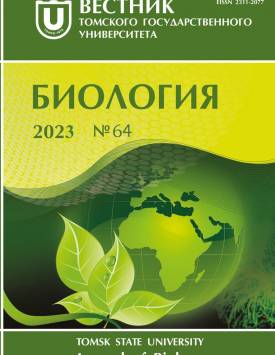Geography of the Wormwoods of Southern Siberia
The Artemisia L. genus (wormwood) occupies one of the leading positions in the floras of the Northern Hemisphere in terms of species richness. Species containing BAS (biologically active substances) are known among the wormwoods with medicine remedies produced on their basis. The representatives of the genus are widely distributed on the territory of Southern Siberia, where they are the main component of the vegetation. The Artemisia L. genus has several centres of species diversity © Ревушкин А.С., Чигодайкина Д.С., 2023 and richness, among which stands out the Angarsk centre, located in the south of Siberia. However, determination of its boundaries, identification of the species composition, the ratio of floristic complexes among wormwoods, and elucidation of its role in the formation of this genus in other floras were not carried out. To solve the above listed issues and due to a high prospect of wormwoods, the goal of a comprehensive geographical study of wormwoods was set in this area. The study object was the species of the Artemisia L. genus of the flora of Southern Siberia. When identifying the species composition of the genus, the following sources were used: the herbarium collections of the Herbarium named after P.N. Krylov (TK), the Herbarium of the Central Siberian Botanical Garden (NSK, NS), the material collected by the authors during their routing field work, which was carried out from 2019 to 2021 in Gorny Altai, Khakassia, Tyva and Kulunda, and numerous literature sources. To determine the boundaries of the Angarsk centre and the features of the wormwoods distribution in the territory of Southern Siberia, chorological and belt/zone were analysed and the similarity degree of the wormwood species composition in the sectors of Southern Siberia and adjacent territories was established. Southern Siberia is the territory within 49-57° North and 65-120° East, stretching 850 km north to south and almost 4000 km west to east. Taking into account the features of orography and physiographic conditions, 5 longitudinal sectors were identified: West Siberian (WS), Altaian (Al), Sayano-Tuvinian (ST), Transbaikalian (Tb), and Daurian (Da). In the flora of Southern Siberia, 82 species of wormwoods from 3 subgenuses (Artemisia Less., Dracunculus Bess., Seriphidium (Bess.) Roy) and 7 sections (Vulgaris Less., Abrotanum Bess., Absinthium DC., Dracunculus (Besser) Rydb., Campestris Krasch. ex Korobkov, Sclerophyllum Filat., Halophyllum Filat.) were identified. The largest number of wormwood species is observed in the ST sector (48 species), the smallest is represented in the WS sector (29 species in total), and about 40 species of the genus are found in other sectors. Of the 82 species of Artemisia L., 27 species have a limited geographical range and are endemic species. Their distribution is within limits of the Altai-Sayan and Transbaikalian floristic provinces with 13 species being local endemics. The distribution of species by belt/zone groups reflects their close association with mountain-steppe and steppe floristic complexes; the number of steppe and mountain-steppe species in these belt/zone groups is 35 species each. The steppe and mountain-steppe belt/zone groups (35 species each) prevail in this territory. The mountain-steppe species prevail in most of Southern Siberia, except for the western part (3 species). The steppe species are diversely represented (25 species) in the western wedge of Southern Siberia, but moving eastwards, the number of species in the steppe group decreases. The chorological analysis made it clear that wormwoods with the Asian distributional type prevail in the territory of Southern Siberia. More than two thirds of the wormwood species in Southern Siberia are within limits of Asia according to their distribution, almost half of them are South Siberian species. Asian species of wormwoods are found in small numbers in the WS sector and are richly represented in other sectors of Southern Siberia. This predominantly testifies to allochthonous trends in the development of the plain floras of Western Siberia and strongly-pronounced processes of autochthonous development of the mountain floras of Southern Siberia. When establishing the similarity degree of the species composition in the sectors of Southern Siberia, it was shown that the highest degree is in the Tb and Da sectors (0.71) and the lowest is in the WS sector. The carried-out assessment of the impact of Southern Siberia on the species composition of wormwoods in the floristic provinces of Asian Russia made it clear that this territory had a great influence on the formation of the species composition of wormwoods in the Tunguska-Lena, West Siberian, and Amur provinces; the influence of Southern Siberia is least manifested in the Okhotsk and Northeastern provinces. Thus, the comprehensive geographical analysis of the wormwoods of Southern Siberia made it possible to clarify the boundaries of the Angarsk centre of wormwood richness and diversity, which covers almost the entire territory of Southern Siberia and Northern Mongolia with the exception of the West Siberian sector, and establish the number of species growing on the territory of Southern Siberia The article contains 3 Figures, 1 Table and 30 References. The Authors declare no conflict of interest.
Keywords
Artemisia L., Southern Siberia, belt/zonal distribution, area analysis, endemics, relictsAuthors
| Name | Organization | |
| Revushkin Alexander S. | National Research Tomsk State University | alrevushkin@gmail.com |
| Chigodaykina Darya S. | National Research Tomsk State University | dashachigodaykina@mail.ru |
References

Geography of the Wormwoods of Southern Siberia | Vestnik Tomskogo gosudarstvennogo universiteta. Biologiya - Tomsk State University Journal of Biology. 2023. № 64. DOI: 10.17223/19988591/64/5
